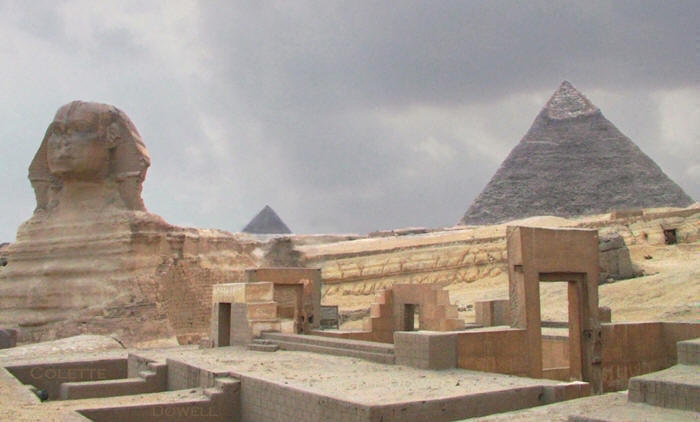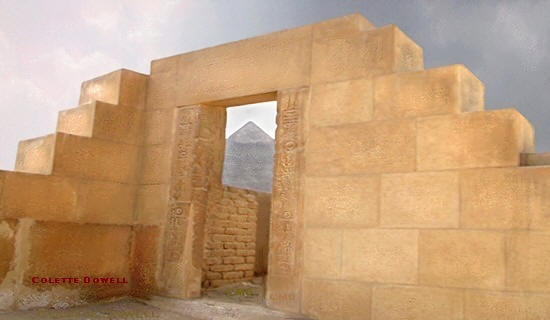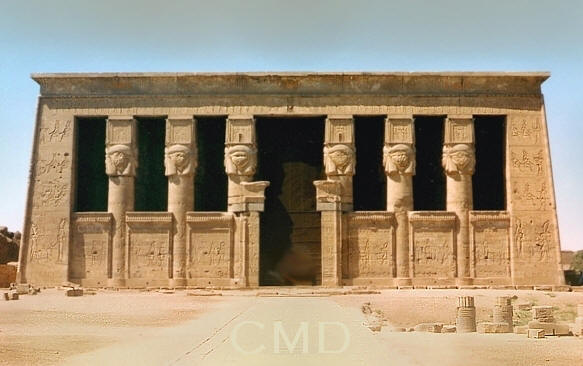 CIRCULAR
TIMES
CIRCULAR
TIMESAncient Egyptian Timeline Old-New Kingdom timeline in simple form to understand Pre Dynastic to New Kingdom, Upper and Lower Egypt
An International Networking Educational Institute
Intellectual, Scientific and Philosophical Studies
CIRCULAR TIMES HOMEPAGE CONTACT SITE NAVIGATION HIGHLIGHTED TABLE OF CONTENTS
A SURREALISTIC VIEW OF
ANCIENT EGYPT'S TIMELINE

Preface
Many times I stumble on Egyptian jargon of Pre-Dynastic this and which Dynasty that, Old Kingdom in Lower Egypt (Delta) vs. New Kingdom in Upper Egypt, Ra, Isis, Horus, Akhenaten, Khufu or Khafre, or none at all, Temple or Mastaba, this or that and so on and so forth. Hence, I decided to make a simple timeline including a few Egyptian concepts and historical venues. This little Egyptian timeline serves a simple purpose by keeping things simple and if there is a need to complicate things a bit more, well at least there is a guide and timeframe to go by that is not too overwhelming to comprehend. I have bold typed key words to impress them in the mind as they seem to be of importance to understand Egypt’s development through her most controversial times. I hope this helps you too. Colette Dowell
ANCIENT EGYPTIAN TIMELINE
Introduction
There is evidence of human occupation in the Land of Egypt c. 200,000 BC , being that of the – Nomadic – Hunter Gatherer stage of human evolution. After the last Ice Age c. 10,000 BC, climatic change begins and temperate zones appear allowing agriculture possible due to the Sun and annual inundation of the river Nile, where Villages and Central Communities begin to emerge. Boats were first made from papyrus; secondary wood. The river Nile served as a central trade route for exchange of gold, pottery and other cultural expressions that began to develop and the era of the Predynastic Period of Egypt c. 5500 BC begins. Egypt’s two separate kingdoms, Lower Egypt (Delta) and Upper Egypt, are relative in terms to the flow of the river Nile. The Early Dynastic Period of Egypt c. 3100 BC unifies Lower and Upper Egypt. The Capital & Royal Court are based in Memphis, and Abydos is the Main Necropolis.
Order From Chaos
PREDYNASTIC PERIOD c. 5500 BC—c. 3100 BC
Upper and Lower Egypt; Distinct Anatomical Differences; Separate Gods evolve into assimilated Gods; Sacred Symbols—Lotus & Papyrus. Death-Rebirth Cycle of two great natural elements / forces = Sun and the Nile. Afterlife and Funerary Rituals—Bodies placed facing West—Sunset. Earliest body preservation—shrouded and laid in desert sand. Migrants from Nubia, Palestine & Syria. Migration to the North of Egypt (Lower Egypt). Hieroglyphs develop c. 3400 BC.
EARLY DYNASTIC PERIOD c. 3100 BC—c. 2686 BC
First and Second Dynasties:
Narmer — (Menes, possibly same person) First Ruler of Dynastic Period. Scorpion — One of the last Rulers of this period. Kingship develops secular power over Two Lands and identify themselves as an embodiment with Gods; Horus, the Sun God Re and the Son of Re. Capital & Royal Court-Memphis; Abydos is Main Necropolis. Mastaba Tombs built from mudbrick and Mortuary Temples housed the Deceased’s ka; a Spirit Force surviving death. Stelae is an inscribed slab inside and outside of Tombs and Temples depicting information of that particular King and Deity associated with him. First calendrical system based on astronomical measurements and Hieratic Script developed.
OLD KINGDOM c. 2686 BC—c. 2181 BC
Third – Sixth Dynasties:
Sophistication of Society and Pharaonic era begins. Technology advances along with culture. Imhotep, vizier to King Djoser, designs the first Stepped Pyramid, c. 2650, known as “Djoser’s Stepped Pyramid,” located in Saqqara, constructed by stone and built by Egyptians who believed their Afterlife was dependent on the glories of their King’s Funerary Monument; the Pyramid.

What we visualize as “True Pyramids” were built in the 4th Dynasty on the Giza Plateau. The first of these, “The Great Pyramid,” supposedly was built by Khufu, the Second Pyramid-Khafre and the Third Pyramid-Menkaure, near the Great Sphinx, whose date of construction deemed by Orthodox Egyptologist’s view is that of c. Khafre.
The Nemes Headcloth and ceremonial false beard was part of the Royal regalia. Even Isis was known to wear a beard to portray her as a Pharaoh. Boats played a significant role in the funerary beliefs. The Sun God Re was believed to travel through the skies and the Underworld by the Solar Barque, (vessel-boat) and after death the King was thought to embark on a similar journey. 1200 pieces of wood, material used for a vessel was uncovered in Giza in 1954, taking 10 years to reconstruct what is possibly Khufu’s funerary Barque or “vessel.” The traveling across the Nile from East to West was ritualistic as the Sun rising in the East and setting in the West. For this reason the causeways of Mortuary Temples began being situated on the Eastern Face of the Pyramid of Kings, leading to the riverbanks of the river Nile. These causeways were also used for transporting materials across the Nile.
FIRST INTERMEDIATE PERIOD c. 2181 BC—c. 2055 BC
Seventh — Eleventh Dynasties
Long periods of instability due to provincial rules warring for control. Political upheaval and decline in economics, famine prevails. There was a rise in the prominence of Osiris during this time, most likely due to the need of survival and the belief of resurrection; as of this time all of Egypt, both Upper and Lower were in a state of despair. The Rulers who originated from Herakleopolis during the 9th Dynasty gained control and were in conflict with Theban Princes, later who gained either the diplomatic or military victory over the Herakleopolis Rulers. Mentuhotep II founded the 11th Dynasty creating order once again and prosperity was finally restored to Egypt, thus the Osirian Legend performed a remarkable trend of belief and following. The Royal Court was moved to Thebes during this time.
MIDDLE KINGDOM c. 2055 BC—c. 1650 BC
Eleventh — Fourteenth Dynasties
The second great era of Egypt with the Golden Age of prosperity and achievement. Amenemhat I was founder of the 12th Dynasty and Itjtawy becomes the new Capital of Egypt. Karnak was established through Osiris and Amun was pre-eminent in this era. Abydos was the most important pilgrim center of trade and political standing. Later another decline set into Egypt as the migrating Middle Easterners, the Hyksos invade and settle in Egypt. This era began the age of Bronze smelting.
SECOND INTERMEDIATE PERIOD c. 1650 BC—c. 1550 BC
Fifteenth — Seventeenth Dynasties
The Hyksos ruled and established themselves with a Capital in Avaris in the Delta (Upper Egypt), while other Indigenous Rulers held other territories. Egypt began to decline again in central power. However the Hyksos did bring in a new era for Egypt as they brought in arts, and culture. This was the first era to see the chariot and advancement in military technology. The horse, lute and lyre came in the 16th Dynasty. During the 17th Dynasty the Hyksos ruled from Thebes. However there was so much tension and decline of power the Theban Princes conquered the Hyksos so once again Egypt was in the hands of her native peoples. The 18th Dynasty was founded under Ahmose I.
NEW KINGDOM c. 1550 BC—c. 1070 BC
Eighteenth — Twentieth Dynasties
Theban God Amun was attributed to the new era of Egypt and prosperity after the expulsion of the Hyksos. Amun synchronizes with Re and Amun-Re was now the Eminent Deity. You see much of Amun –Re in the Karnak Temple as well as that of Luxor and the surrounding great Temples built in the times circumscribing these three dynasties. Tuthmosis III is Egypt’s greatest Warrior King and expansion with annexing of Nubia, Palestine and Syria. The Solar Deity Aten, becomes a very popular cult under the ruling of Amenhotep IV, who proscribed all other Gods.
Amenhotep IV changes his name to Akhenaten and moves the Royal Court to modern day area of Tell el Amarna. Later Tutankhamun restored the traditional pantheon. Rameses I founded the 19th Dynasty and now Qantir is new Capital. Many invasions by Libyans, Nubians and others to create chaos; Egypt prevails. Valley of the Kings at Thebes is established as the Royal Necropolis. The Ramessid Era had seen tremendous hardships and civil and economic unrest while the Royal Authority declined. The Cult of Osiris & Isis became most prominent in the New Kingdom, c. 1550 BC – 1070 BC.
THIRD INTERMEDIATE
PERIOD c. 1070 BC—c. 747 BC
Twentyfirst — Twentyfourth Dynasties
Smendes founded 21st Dynasty and Tanis in the Delta is ruling Capital. The High Priests of Amun rule Southern Egypt from Thebes. Later two lineages marry and blend, helping the rivalry of Lower and Upper Egypt. Egypt is united once again while being ruled under concurrent powers. The dominant power in the Delta was that of Sais. Piy was Ruler of the Southern Kingdom and Napata is Capital. New age of Iron working.
LATE PERIOD c. 747 BC—c. 332 BC
Twentyfifth - Thirtieth Dynasties
Shabaqo from Napata conquered the whole of Egypt and founded the 25th Dynasty. Assyrians invaded and established Saite Lineage to rule Egypt. Babylonia rises to power and wipes out the Assyrians, then Persia invades the Assyrians as dominant power and the 26th Dynasty is established. The Egyptian Natives however finally expel the Persians by the Saite leader known as Amyrtaios. Many invasions and conquests during this time with change of Rulers. Lineage from Mendes founds 29th Dynasty. Nectanebo I re-conquers all of Egypt. And to finalize this era, Alexander the Great invaded Egypt and Egypt falls into control of the Greeks; Alexandria becomes the new Capital.
GRAECO-ROMAN PERIOD c. 332 BC—AD 641
Alexandria & Beyond
Alexander the Great had conquered Egypt along with all of her glories. The Macedonians were ruling Egypt, yet this was a welcomed occupation as they had driven the Persian invaders out of Egypt which had bound them and caused great decline. Alexandria was a great Capital City, housing the Great Alexandria Library that is so famous for its burning to the ground during the Roman invasion c. 30 BC, somewhere near the reign of Cleopatra VII. Previous to the Roman invasion, Egypt was ruled under the Ptolemies, a long lineage descended from one of Alexander’s great Generals. Kings assumed the role of Pharaoh and this was an era of great Temple building.
In 196 BC decree commemorating Ptolemy V’s coronation; as slab of inscribed basalt depicts this decree and was later to be found by a French soldier named Pierre Poushar in 1799, in Rosetta – a small village near the river Nile and is known as the Rosetta Stone. The Temples at Dendera show magnificent hieroglyphics of this era of occupation with Caesar, Mark Antony and Cleopatra.

Dendera is also known for the great Temple of Hathor and the amazing Ceiling Zodiac. Beginning with the ruling under Rome when Octavian invaded Egypt for the main purpose of her rich grain. Christianity spread through Egypt during the time of Constantine. Greek still remained the official language until the Arabs invaded in AD 641 and Islam became the predominant Religion and Language. However, Christianity remained and the influence of the Coptic Church. Both the Coptic Church and Islamic or modern day Muslim are recognized in modern day Egypt along with other nationalities and faiths.
Cairo is now the Main Necropolis and Capital of Egypt located in the Upper Land (Delta) of Egypt. Giza is a small town next to Cairo, where the Great Pyramid and the Great Sphinx are located next to the river Nile. So – here we are now – modern Egypt!
Colette M. Dowell
Bibliography
Ancient Egypt: Kingdom of the Pharaohs, R. Hamilton, Parrogon Publishing
British Museum Dictionary of Ancient Egypt, Ian Shaw & Paul Nicholson, BCA
Ancient Egypt: The Great Discoveries, Nicholas Reeves, Thames & Hudson
Dr. Colette Dowell is available for radio interviews and speaking engagements- tour guide to Egypt. Contact for more information. Thank you.
Look at what Sabu the Great Nubian is doing now!
Behold the great treasures I bring to you!
SITE NAVIGATION EASY LINKS TOO
![]()
An International Networking Educational Institute
Intellectual, Scientific and Philosophical Studies
Copyright © 1995, 2005, 2006, 2007